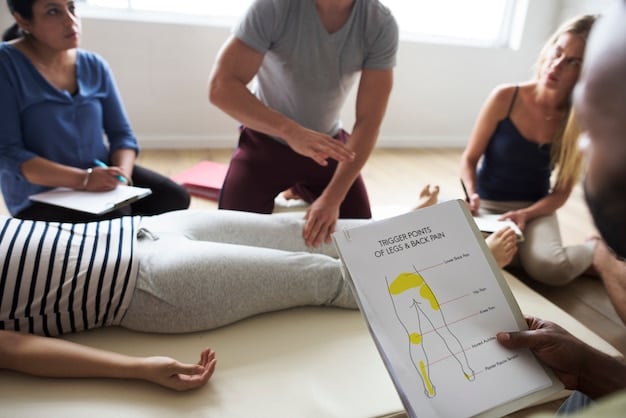Unlock Deeper Focus: Mindfulness Meditation Guide for 2025

Unlock deeper focus in 2025 with this 3-step guide to mindfulness meditation, designed to improve concentration and enhance mental clarity through simple, effective techniques.
Seeking improved focus and concentration in the year ahead? Discover how to unlock deeper focus: A 3-step guide to mindfulness meditation for improved concentration in 2025 can transform your mental clarity and productivity.
Understanding the Core of Mindfulness Meditation
Mindfulness meditation is a powerful tool for cultivating focus and presence. It involves training your mind to pay attention to the present moment without judgment, fostering a sense of calm and clarity.
In today’s fast-paced world, distractions are everywhere, making it difficult to maintain focus. Mindfulness meditation offers a way to counteract these distractions, helping you regain control of your attention and improve concentration.
The Essence of Present Moment Awareness
The core of mindfulness lies in its emphasis on present moment awareness. This means tuning into your thoughts, feelings, and sensations as they arise, without getting carried away by them.
Non-Judgmental Observation
Another key element is non-judgment. As you observe your thoughts, try to do so without labeling them as good or bad, right or wrong. Simply acknowledge them and let them pass.

Mindfulness meditation is not about emptying your mind, but rather about becoming more aware of its contents and learning to relate to them in a new way.
- Reduces Stress: Regular practice can significantly lower stress levels.
- Enhances Focus: Improves your ability to concentrate on tasks.
- Increases Self-Awareness: Helps you understand your thoughts and emotions better.
- Promotes Emotional Regulation: Enables you to manage your emotions more effectively.
By incorporating mindfulness meditation into your daily routine, you can experience these benefits and unlock deeper focus in all areas of your life. This is especially crucial in 2025 as technology and information continue to evolve rapidly, demanding greater mental resilience and adaptability.
Step 1: Setting the Stage for Mindfulness
Creating a conducive environment is essential for effective mindfulness meditation. This involves finding a quiet space where you can relax without distractions and adopting a comfortable posture.
The goal is to minimize external and internal disturbances, allowing you to fully engage in the practice and cultivate a state of focused awareness.
Finding Your Quiet Space
Choose a location where you feel safe and undisturbed. It could be a corner of your bedroom, a quiet garden, or any place where you can escape the noise and demands of daily life.
Adopting a Comfortable Posture
You can sit on a cushion, a chair, or even lie down, as long as you maintain an upright posture that allows for easy breathing. The key is to find a position that is both comfortable and alert.
Experiment with different postures to find what works best for you. Some people prefer sitting cross-legged on a cushion, while others find it more comfortable to sit in a chair with their feet flat on the floor.
- Minimize Distractions: Turn off your phone and any other devices that might interrupt you.
- Create a Routine: Meditate at the same time each day to establish a consistent practice.
- Use Sensory Aids: Consider using soft lighting, soothing music, or aromatherapy to enhance your environment.
By setting the stage for mindfulness, you create a foundation for deeper focus and a more rewarding meditation experience. This preparation is crucial for making mindfulness meditation a sustainable practice in the long run.
Step 2: The 3-Minute Beginner Guided Meditation
A 3-minute guided meditation is a great way to introduce yourself to mindfulness. This brief practice can help you center yourself, quiet your mind, and cultivate present moment awareness.
Guided meditations provide structure and support, making it easier to focus and stay on track, especially when you’re new to mindfulness.
Focus on Your Breath
Begin by focusing on your breath. Notice the sensation of the air entering and leaving your body. Pay attention to the rise and fall of your chest or abdomen.
Scan Your Body
Next, gently scan your body from head to toe. Notice any sensations you might be feeling, such as tension, warmth, or tingling. Simply acknowledge these sensations without judgment.

Allow your thoughts to come and go without getting caught up in them. If your mind wanders, gently redirect your attention back to your breath or body scan.
- Find a Quiet Spot: Choose a calm environment where you won’t be disturbed.
- Sit Comfortably: Adopt a posture that supports relaxation and alertness.
- Close Your Eyes: Gently close your eyes to minimize distractions.
- Breathe Deeply: Focus on your breath to anchor yourself in the present moment.
Even a few minutes of guided meditation can have a profound impact on your focus and well-being. Regular practice can help you develop a greater sense of calm and clarity, enabling you to approach daily challenges with greater resilience and mindfulness.
Step 3: Expanding Your Mindfulness Practice
Once you’ve become comfortable with the 3-minute guided meditation, you can gradually expand your practice. This involves increasing the duration of your meditation sessions and incorporating mindfulness into other areas of your life.
The goal is to integrate mindfulness into your daily routine, making it a natural and sustainable part of your lifestyle.
Gradually Increase Meditation Time
Start by adding a few minutes to your meditation sessions each week. Gradually work your way up to 10, 15, or even 20 minutes, depending on your preference and schedule.
Mindful Walking Technique
Mindful walking is a great way to combine meditation with physical activity. As you walk, pay attention to the sensation of your feet touching the ground. Notice the movement of your body and the world around you.
Consider incorporating mindfulness into everyday tasks, such as eating, washing dishes, or commuting to work. Pay attention to the sensations, thoughts, and emotions that arise during these activities.
- Set Realistic Goals: Don’t try to do too much too soon. Start small and gradually increase your practice.
- Be Patient: Mindfulness takes time and practice. Don’t get discouraged if your mind wanders.
- Find a Community: Connect with other mindfulness practitioners for support and encouragement.
By expanding your mindfulness practice, you can deepen your focus, enhance your well-being, and cultivate a greater sense of presence in your life. This ongoing commitment to mindfulness will help you navigate the challenges and opportunities of 2025 with greater clarity and resilience.
The Proven Benefits of Regular Mindfulness Practice
Regular mindfulness practice offers a wide range of benefits, including improved focus, reduced stress, and enhanced emotional regulation. These benefits can have a profound impact on your overall well-being and quality of life.
Research has shown that mindfulness meditation can lead to significant improvements in attention, memory, and cognitive performance. It can also help reduce symptoms of anxiety, depression, and chronic pain.
Stress Reduction and Emotional Regulation
Mindfulness meditation helps regulate the body’s stress response, reducing levels of cortisol and other stress hormones. It also enhances emotional regulation by increasing your awareness of your emotions and your ability to manage them effectively.
Improved Focus and Cognitive Function
Regular mindfulness practice can improve your ability to focus and concentrate on tasks, enhancing productivity and cognitive performance. It can also increase your awareness of your thoughts and feelings, leading to greater self-understanding and emotional intelligence.
Mindfulness can enhance your relationships by improving your communication skills and increasing your compassion and empathy. It can also foster a greater sense of connection with others and with the world around you.
- Scientific Backing: Studies confirm its effectiveness in reducing stress and improving focus.
- Personal Anecdotes: Many individuals report significant improvements in their mental well-being.
- Long-Term Advantages: Consistent practice builds resilience and mental clarity over time.
By leveraging the proven benefits of regular mindfulness practice, you can unlock deeper focus and enhance your overall well-being in 2025 and beyond. This proactive approach to mental health will empower you to thrive in an increasingly complex and demanding world.
Overcoming Common Obstacles in Mindfulness Meditation
Despite its many benefits, mindfulness meditation can be challenging, especially when you’re just starting out. Common obstacles include a wandering mind, physical discomfort, and lack of time.
The key is to approach these challenges with patience, compassion, and a willingness to adapt your practice to your individual needs and preferences.
Dealing with a Wandering Mind
It’s natural for your mind to wander during meditation. When this happens, simply acknowledge the thought and gently redirect your attention back to your breath or body scan. Don’t judge yourself for getting distracted; just gently guide your focus back to the present moment.
Addressing Physical Discomfort
If you experience physical discomfort during meditation, adjust your posture or take a break. You can also try mindful movement, such as gentle stretching or yoga, to release tension and improve your comfort.
Prioritizing time for mindfulness meditation can be difficult, especially when you have a busy schedule. Start small and gradually increase your practice as you become more comfortable. Even a few minutes of meditation each day can make a difference.
- Be Patient: Don’t expect to become a mindfulness expert overnight.
- Find Support: Join a meditation group or work with a mindfulness teacher.
- Be Kind to Yourself: Treat yourself with compassion and understanding.
By addressing these common obstacles with patience and persistence, you can deepen your mindfulness practice and unlock its full potential. This proactive approach will help you cultivate inner peace, improve focus, and enhance your overall well-being in 2025 and beyond.
| Key Point | Brief Description |
|---|---|
| 🧘♀️ Mindfulness Core | Focuses on present moment awareness without judgment. |
| ⏱️ 3-Min Meditation | Quick guided practice to center your mind and reduce distractions. |
| 🚶♀️ Expanding Practice | Incorporating mindfulness in daily tasks and longer sessions. |
| 🧠 Benefits | Stress reduction, improved focus, and enhanced emotional regulation. |
Frequently Asked Questions
▼
Mindfulness meditation is a mental training practice that involves focusing on your present moment experiences, such as your breath or bodily sensations, without judgment. It aims to increase awareness and reduce mental clutter.
▼
It improves focus by training your brain to resist distractions and concentrate on a single point of attention. Regular practice strengthens the neural pathways associated with attention control, making it easier to concentrate.
▼
Yes, mindfulness meditation is known to reduce stress. It helps by activating the parasympathetic nervous system, which promotes relaxation and reduces the production of stress hormones like cortisol, leading to a calmer state.
▼
Ideally, practicing daily is most effective but even a few times a week can yield noticeable benefits. Aim for consistency, even if it’s just for a few minutes each session, to allow your mind to adapt and grow accustomed to the practice.
▼
Common challenges often include a wandering mind, difficulty staying focused, and physical discomfort. Overcoming these involves patience, self-compassion, and adjusting your meditation environment or posture to ensure comfort and reduced distractions.
Conclusion
By following this 3-step guide to mindfulness meditation, you can unlock deeper focus, improve your concentration, and enhance your overall well-being in 2025 and beyond. Embrace the journey with patience and consistency, and experience the transformative power of mindfulness in your life.





